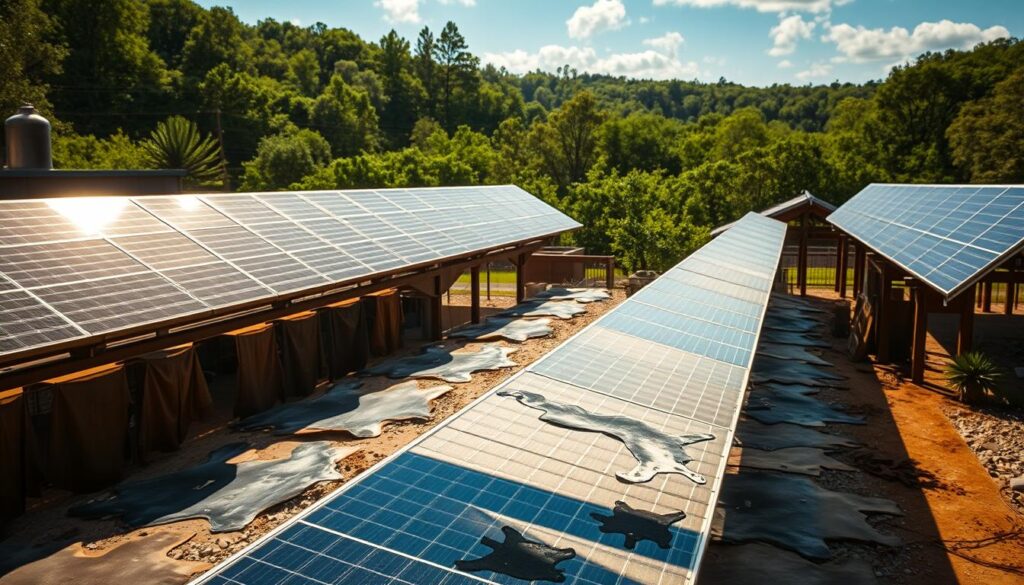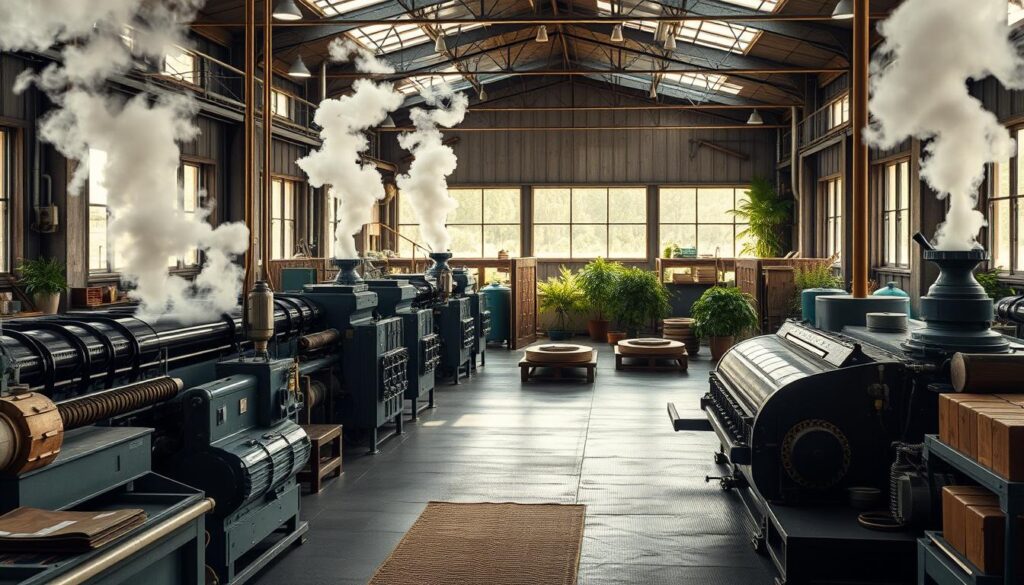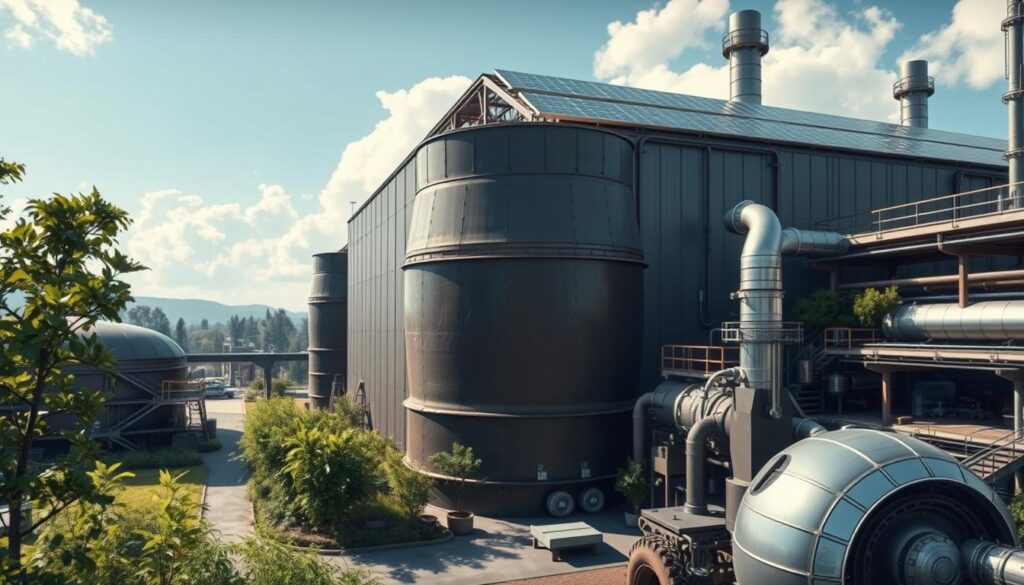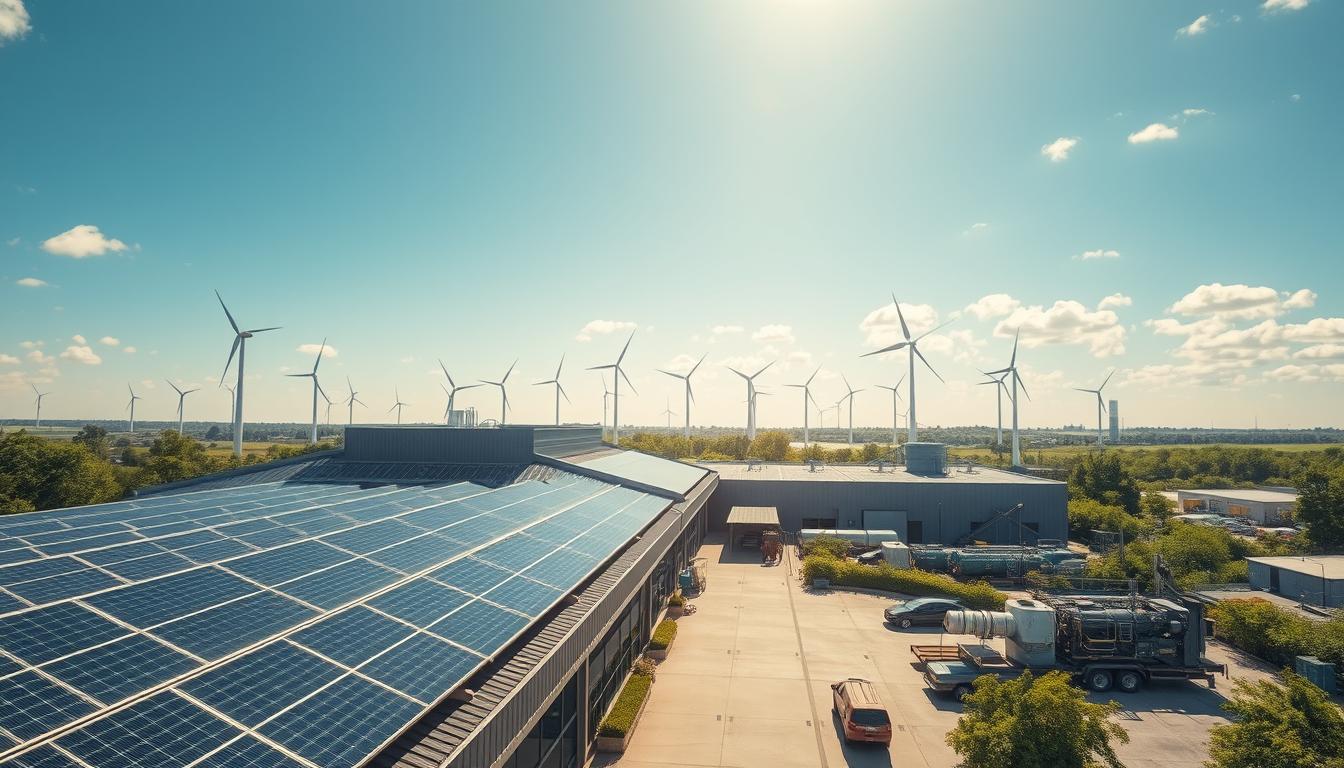I’ve seen a big problem in the leather world. Old tanning ways use a lot of energy and harm the planet. Did you know tanneries might use up to 30 kW to make one hide? This huge energy use raises costs and pollutes a lot.
We need to find better ways to tan leather. Making green leather is key for the industry’s future. Using renewable energy in leather plants is a great idea. It makes leather making cheaper and better for the planet.
Key Takeaways
- Tanneries require up to 30 kW of energy per finished hide
- Energy costs account for 3-5% of annual operating expenses
- Renewable energy can reduce CO2 emissions and operating costs
- Solar and biomass energy are viable options for tanneries
- Sustainable practices can give a competitive edge in the market
Introduction to Sustainable Leather Manufacturing
I’ve been looking into sustainable tanning methods. It’s exciting to share what I’ve found about green leather making. The leather industry is moving towards eco-friendly ways, and renewable energy is leading the change.
The Environmental Impact of Traditional Leather Processing
Traditional leather making harms our planet a lot. It uses lots of water and chemicals, causing pollution and waste. I was amazed to learn that animal leather production is over 20 billion square feet each year! We really need to fix this environmental damage.
The Need for Green Solutions in Tanneries
Tanneries are now focusing on sustainable tanning. I see more plant-based leathers made from cork, pineapple leaves, and even mushrooms. These options are kind to animals, use less resources, and turn waste into something useful.
| Material | Benefits |
|---|---|
| Cork | Water-resistant, scratch-resistant |
| Pineapple leaf fiber | Repurposes waste, durable |
| Mushroom leather | Sustainable, eco-friendly |
Renewable Energy as a Game-Changer
Renewable energy is changing green leather making. It cuts down emissions and makes tanneries more sustainable. The vegan bio-based leather market is growing fast, with a 37.4% CAGR from 2024 to 2034!
Over $1 billion has been invested in alternative leather materials. It’s clear that sustainable leather making is the future. I’m looking forward to seeing how these new ideas will shape the industry and make fashion more eco-friendly.
The Leather Industry’s Environmental Challenges
I’ve been looking into the leather industry’s environmental impact. The findings are shocking. Green leather making faces big challenges to cut its environmental harm. The tanning process uses a lot of resources and pollutes a lot.
Using sustainable tanning methods is key. Old ways use up to 2.5kg of chemicals and 250 liters of water for every kilogram of leather. This also makes about 6.1kg of solid waste. The industry also harms land and causes deforestation.
Livestock farming, key to leather making, is a big source of greenhouse gas emissions. Cattle, in particular, release methane and nitrous oxide. These gases are worse for the planet than CO2. The water needed for cattle and tanning is also a big concern.
| Environmental Challenge | Impact |
|---|---|
| Water Usage | Up to 250 liters per kg of leather |
| Chemical Use | Up to 2.5kg per kg of leather |
| Solid Waste | Up to 6.1kg per kg of leather |
| GHG Emissions | 14.5% from livestock farming |
The industry’s old tech in developing countries makes things worse. It uses more energy and makes more CO2. We must tackle these issues to make tanning and leather making green and sustainable.
Renewable Energy in Leather Processing Plants: An Overview
I’ve seen a growing trend in the leather industry towards sustainable practices. Renewable energy in leather processing plants is changing the game. Tanneries are looking into green energy options to cut down on costs and harm to the environment.
Types of Renewable Energy Suitable for Tanneries
Several renewable energy sources are good for leather processing:
- Solar power for electricity generation
- Wind energy to power machinery
- Biomass energy for tanneries, using waste materials
- Hydroelectric power for facilities near water sources
- Geothermal energy for heating and cooling processes
Benefits of Adopting Renewable Energy Sources
The benefits of green energy in leather production are big:
- Less carbon footprint and environmental harm
- Lower costs over time
- Better sustainability image
- Potential for government incentives
- Better brand image with eco-aware customers
Overcoming Implementation Challenges
But, there are some hurdles to using renewable energy:
- High upfront costs
- Need for changes to infrastructure
- Training staff on new tech
- Dealing with complex rules
Despite these challenges, many tanneries are making the switch to renewable energy. This is helping make the leather industry more sustainable.
Solar Power: Harnessing the Sun’s Energy in Tanneries
I’ve seen how solar power is changing the leather industry. It’s a great time for green energy in leather making. Let’s look at some examples that show solar’s big impact.

Fibre by Auskin uses solar panels to heat 2,000,000 liters of water every week. This has cut their water use by 15% each year for five years. They also use 70% of their water again, making things more eco-friendly.
Tannery Film Studios is another great example. They have one of the biggest solar arrays in the area. They use this power for their facilities. When they need more, they get 100% green energy from elsewhere. This move helps the environment and draws in clients who care about the planet.
Here’s a summary of solar power’s benefits in tanneries:
| Benefit | Impact |
|---|---|
| Water Heating | 2,000,000 liters per week |
| Water Use Reduction | 15% annually |
| Water Recycling | 70% of total used |
| Carbon Emission Reduction | Substantial |
| Energy Cost Savings | Significant |
Solar air drying systems are also a big deal. They cut energy costs and don’t make any pollution. It’s clear solar power is leading the way to a greener leather industry.
Wind Energy: Powering Leather Production with Air Currents
The leather industry is moving towards wind energy. This change is exciting for the future of leather making. Tanneries are using wind power to save money and reduce harm to the environment.
Wind Turbine Installation for Tanneries
Wind turbines are becoming common in leather plants. They turn wind into electricity, helping with leather making. The setup is simple: tall towers with blades catch wind and make power for the plant.
Cost-Effectiveness and Energy Output
Wind energy is now cheaper for leather makers. Costs to start up have gone down, and power output has gone up. A good turbine can power a lot of a tannery, saving a lot on bills.
Success Stories in the Leather Industry
Many tanneries have found wind energy works well. For example, a big leather maker now uses only renewable energy. This cut their carbon output by 10%.
Another tannery cut their lighting energy use by 80% with wind power. These stories show wind energy is good for leather making. More tanneries using it means a greener future for leather.
Biomass Energy: Turning Waste into Power
I’ve found out that Biomass Energy for Tanneries is a big change for the leather world. Tanneries make a lot of waste, about 600,000 tons every year. But, we can make power from this waste!
Waste-to-Energy Solutions are changing how tanneries work. Only 20% of raw materials become finished leather. The rest is waste. Now, we use this waste to make energy.
- 40-50% of hides become shavings and trimmings
- 56-60% of waste is fleshing
- 35-40% is chrome shaving, splits, and buffing dust
- 5-7% comes from skin trimming
- 2-5% is hair waste
Now, let’s talk about the cool part. Through gasification, we can get up to 70% of the energy from waste. This makes a fuelgas that’s mostly carbon monoxide, hydrogen, and methane.
| Waste Type | Energy Potential | Usage |
|---|---|---|
| Solid Waste | 1kw/h per 1kg | Electricity generation |
| Wastewater | 1.7 kWh electricity, 2.5 kWh heat per m3 biogas | Combined heat and power |
| Fuelgas | Varies | Boiler applications, thermal oxidizers |
This tech is great for everyone. It cuts down waste, lowers energy costs, and makes leather making better for the planet. I’m looking forward to more tanneries using these Waste-to-Energy Solutions. It will make the leather industry greener.
Hydroelectric Power: Tapping into Water Resources
Hydroelectric power is getting popular in tanneries. It’s a clean energy source that meets their high water and energy needs.
Small-Scale Hydroelectric Systems for Tanneries
Small hydroelectric systems are changing the game for tanneries near water. They provide constant renewable energy, cutting down on traditional power use. Tanneries are using micro-hydro turbines in rivers or streams to power their work.
Environmental Considerations and Permits
Before setting up hydroelectric systems, tanneries must think about the environment and get permits. They check water flow, look at how it might affect local ecosystems, and follow rules. Proper planning is key to help both the tannery and nature.
Potential Energy Savings and ROI
Hydroelectric power can save a lot of money and energy for tanneries. Here’s what you can expect:
| Benefit | Impact |
|---|---|
| Energy Cost Reduction | Up to 40% savings on electricity bills |
| Carbon Footprint | Reduction of 50-70% in CO2 emissions |
| ROI Timeline | 5-7 years for full system payback |
| Operational Lifespan | 20-30 years with proper maintenance |
Hydroelectric power is a good choice for tanneries wanting to use renewable energy. With good planning, it offers big benefits for the environment and the business.
Geothermal Energy: Harnessing Earth’s Heat for Leather Processing

Geothermal energy is changing the leather industry. It uses the Earth’s heat, making leather processing more sustainable. The Earth’s heat is huge, with 12.6 x 10^24 MJ of it.
Geothermal energy is becoming popular in leather processing. It offers a steady heat source for tanning, cutting down on fossil fuel use. Tanneries can keep the right temperature all year with geothermal heat pumps, saving money and reducing pollution.
More leather processing plants are using renewable energy. Geothermal systems are especially good in areas with lots of geothermal activity. They can make electricity and provide direct heat, helping tanneries a lot.
Here’s a breakdown of geothermal energy’s potential:
- Potential geothermal electricity ranges from 35-70 GW to a maximum of 140 GW
- Technical potential for geothermal resources suitable for electricity generation is estimated at 210 GW
- Geothermal resources could produce up to 8.3% of the world’s total electricity
I’m excited about geothermal energy in leather processing. As more tanneries use it, we’re getting closer to a greener leather industry. It’s good for the planet and helps tanneries work better.
Biofuel Adoption: A Sustainable Alternative for Tanneries
I’ve noticed a rise in Biofuel Adoption in Tanneries. They’re using biofuels to reduce fossil fuel use and look greener.
Types of Biofuels for Leather Processing
Biogas from leather waste is a big deal. It has heating values between 13.1 and 29.4 MJ per cubic meter. This can meet up to 15% of a tannery’s energy needs or 31% of its electricity.
Implementing Biofuel Systems
Setting up biofuel systems in tanneries is a big job. It often means changing existing equipment. But the benefits are huge.
Biogas production from leather waste is a great example. The protein-rich leftovers are perfect for anaerobic digestion. But, high ammonium levels can lower methane production.
Environmental and Economic Benefits
Using biofuels has two main benefits. It cuts down on greenhouse gas emissions. It also saves money on fuel and can get government incentives.
Some tanneries are already seeing these benefits. This is making more tanneries want to use biofuels.
Biofuels are a good choice for tanneries wanting to be more eco-friendly. As more success stories come out, I think we’ll see more tanneries using biofuels. This will make Sustainable Tanning Methods even more popular.
Waste-to-Energy Solutions in Leather Manufacturing

The leather industry makes a lot of waste. For every 1000 kg of raw hide, about 850 kg is solid waste. But, new Waste-to-Energy Solutions are changing this in Green Leather Manufacturing.
A typical tannery has a lot of waste. Here’s what it looks like:
- Fleshing: 56-60%
- Chrome shaving, splits, and buffing dust: 35-40%
- Skin trimmings: 5-7%
- Hair: 2-5%
We’re now turning this waste into energy. This is a big change for the industry. It’s not just about less waste. It’s about making something valuable from it.
One method I’m excited about is anaerobic digestion. It breaks down organic waste into biogas. This biogas can power the tannery. Another method is burning non-recyclable materials to make heat and electricity.
These Waste-to-Energy Solutions are changing Green Leather Manufacturing. They’re saving money on waste disposal and creating renewable energy. It’s good for the environment and the company’s profits.
Energy Efficiency Measures Complementing Renewable Sources
I’ve seen how energy efficiency boosts renewable energy in leather plants. These steps cut costs and reduce harm to the environment. Let’s look at some key strategies for Green Leather Manufacturing.
Upgrading equipment is a big change. New machines use less power and make better leather. I’ve seen plants save 30% on energy with new drum systems. Better insulation in buildings and pipes also helps a lot.
Optimizing production is key for Sustainable Tanning Methods. This means using energy when it’s cheapest or most available. Energy management systems help find ways to save more.
| Measure | Potential Energy Savings |
|---|---|
| Equipment Upgrades | 20-40% |
| Improved Insulation | 10-15% |
| Process Optimization | 15-25% |
| Energy Management Systems | 5-10% |
By using these steps with renewable energy, tanneries see big changes. I’ve seen plants cut energy use by up to 50%. This makes a big difference in their green journey.
Government Incentives and Support for Green Energy in Tanneries
I’ve seen a big change in government support for green leather making. Many countries now offer incentives for sustainable tanning. This change is making the leather industry greener.
Tax Credits and Grants for Renewable Energy Adoption
The European Union is at the forefront with its SWITCH Africa Green program. It funds projects that help African countries go green. In Ethiopia, with its huge number of livestock, this support is very important.
The program helps connect Ethiopian leather makers with European companies. It aims to create sustainable business ties.
Regulatory Framework Supporting Sustainable Practices
Governments are making policies to help green businesses grow. They offer incentives that make sustainable tanning more appealing. In Tamil Nadu, India, new rules are pushing for better waste management.
There, 500 MSME tanning companies employ about 40,000 workers. These new rules are helping improve how they handle waste.
International Initiatives Promoting Green Leather Production
Global efforts are pushing for circular tanning practices. In Tamil Nadu, a program is introducing better tanning and waste treatment technologies. It’s helping SME tanneries grow and promoting circular products.
The goal is to cut down solid waste, improve health, and make leather exports more competitive.
These efforts are changing the leather industry. Governments are supporting green leather making and sustainable tanning. This is leading to a greener future in leather production.
Case Studies: Successful Implementation of Renewable Energy in Tanneries
I’ve seen amazing changes in the leather industry. Tanneries worldwide are using renewable energy. This leads to more sustainable ways of tanning leather. Let’s look at some success stories.
In Bangladesh and India, tanneries are switching to solar power. This move cuts their carbon footprint and energy costs. Energy costs are a big part of a tannery’s expenses.
Energy-saving efforts are also happening in Argentina, Egypt, Italy, Mexico, Sri Lanka, Tunisia, and Turkey. These countries show that green tanning works everywhere. For example, a Spanish tannery greatly reduced its energy use.
The Leather Working Group (LWG) is leading this green change. They rate tanneries on energy use, from Audited to Gold. This pushes tanneries to get better and use renewable energy.
- Administration improvements
- Engineering upgrades
- Space heating optimization
- Efficient fork trucks
- Wastewater treatment enhancements
These stories show that renewable energy in tanneries is real and working. More tanneries are joining, making leather production greener and more sustainable.
Overcoming Challenges in Transitioning to Renewable Energy
Switching to renewable energy in leather plants is hard. Green leather making faces big costs and tech issues. But, it’s definitely doable.
Let’s look at some big challenges and how to solve them:
- High initial costs: Look for government grants or start small
- Technical complexities: Train your team well
- Resistance to change: Share your wins with others
Studies show more people want to go green. In leather production, 30 out of 39 studies on Life Cycle Assessment were from the last 6 years. This shows the industry is moving towards eco-friendly ways.
| Challenge | Solution |
|---|---|
| Energy shortages | Use reliable renewable energy |
| Waste management | Try waste-to-energy tech |
| Environmental impact | Use circular economy ideas |
By tackling these issues, we can make leather plants use more renewable energy. It’s a tough path, but it’s key for a greener future.
The Future of Sustainable Leather Processing
I’m excited about the future of sustainable leather processing. The industry is on the brink of a green revolution. New technologies are making eco-friendly practices common.
Emerging Technologies in Renewable Energy
Green leather manufacturing is getting a boost from new energy solutions. Some tanneries use solar panels and wind turbines. These clean energy sources lower carbon footprints and costs.
Predictions for the Leather Industry’s Green Transformation
I predict a big shift towards sustainable practices soon. Studies show rPVB leather has a 60% lower carbon footprint than traditional leather. The global synthetic leather market is expected to hit $85.05 billion by 2025.
Potential for Circular Economy in Leather Production
The leather industry is moving towards a circular economy. Recycling and upcycling discarded leather products are now common. Companies like Carter Industrial Company are leading this change. They received certification for their sustainable products.
